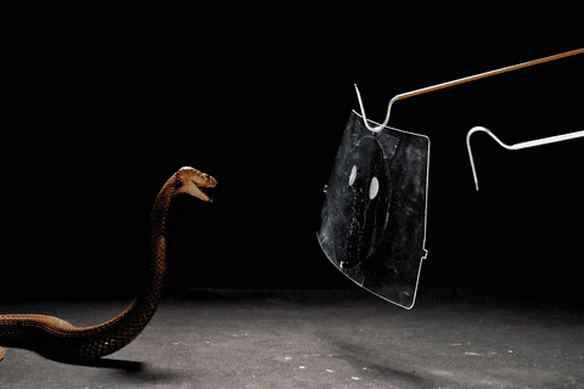By Angus Dalton
If a cobra strike doesn’t kill you, the snake’s potent venom can eat into your flesh, inducing necrosis and often forcing the amputation of festering limbs. Thousands of people meet such a fate each year.
But now scientists from the University of Sydney have uncovered a new antidote for cobra venom, after previously discovering new cures for box jellyfish stings and poison from death cap mushrooms.

A Nubian spitting cobra unleashes its venom.Credit: Credit: The Trustees of the Natural History Museum, London & Callum Mair
Using a pioneering gene editing technique that pinpoints which specific genes different venoms target in the body, Professor Greg Neely is hunting for toxin-busting antidotes for all manner of deadly creatures’ venom.
“Our goal in 10 years from now would be to have developed multiple broad-acting venom antidotes that can protect you from the most dangerous animals in your region,” Neely said.
Upon moving to Australia, Neely, an expert in functional genomics who hails from Canada, was intrigued by the raft of resident fanged and tentacled creatures that can kill. He started with the most venomous creature on earth, the box jellyfish.
Neely’s team takes thousands of human cells and, using the DNA-snipping technology CRISPR, chops out a single gene from each cell. Then they add venom.

PhD student and venom researcher Tian Du in a lab at Charles Perkins Centre, the University of Sydney.Credit: Fiona Wolf
Most cells die. But the few that survive reveal which genes are interacting with the venom and allowing it to kill.
“We do this on a whole genome level,” said Tian Du, a PhD student in Neely’s lab and lead author of the new cobra research. “It’s a bit of a battle royale situation.”
This method revealed box jellyfish venom requires cholesterol to work, so Neely’s team developed an antidote from existing drugs that reduce cholesterol.
They also discovered death cap mushrooms target a specific enzyme that can be blocked using a common green medical dye, offering a cheap and accessible potential cure.

The technique has revealed new drugs that could cure box jellyfish stings and death cap mushroom poisoning. Up next: bluebottles, black snakes and vipers.Credit: Alamy
Cobras represented a unique challenge. Most snake venoms target the cardiac or nervous system. But many cobra venoms also contain toxins that attack the skin and muscles and induce necrosis, or tissue death, which cannot be treated by current antivenom.
The CRISPR detective work revealed cobra venom was latching on to proteins and enzymes that make sugar molecules on cell surfaces. With that knowledge, the researchers identified a molecule with a similar structure to these enzymes: a cheap, common blood-thinning medication called heparin.
“Giving lots of heparin to the cells as a decoy for the venom seemed to rescue the cells,” Du said. “There was no cell death.” Heparin also halted necrosis in animal trials.
A $10 million human trial will be needed before the cobra antidote can become a reality. Snakebites kill 138,000 people worldwide each year and injure 400,000 more.
Current antidotes are made by injecting venom into horses and sheep and extracting antibodies from the animals’ blood. It’s an expensive, 19th-century process, and cheaper options are needed for those living in at-risk areas across Asia and Africa.
“Our approach should work for most venoms,” Neely said. The lab is now hunting for new antidotes for stings or bites from vipers, bluebottles and Australian black snakes.
The Examine newsletter explains and analyses science with a rigorous focus on the evidence. Sign up to get it each week.